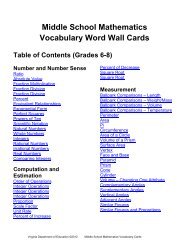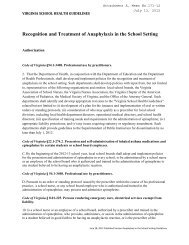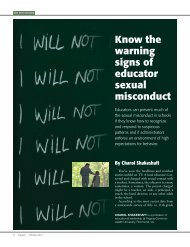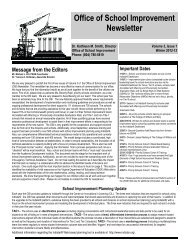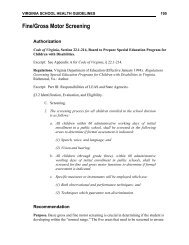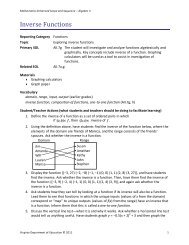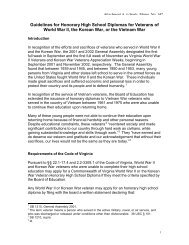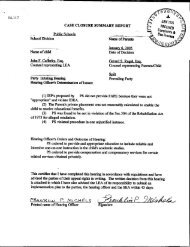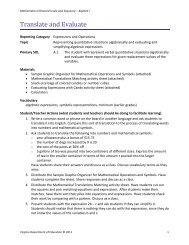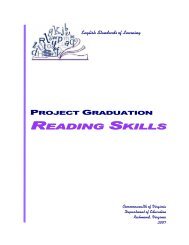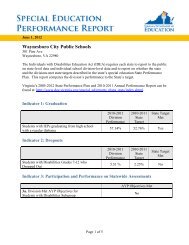What Makes Something Alive - Virginia Department of Education
What Makes Something Alive - Virginia Department of Education
What Makes Something Alive - Virginia Department of Education
You also want an ePaper? Increase the reach of your titles
YUMPU automatically turns print PDFs into web optimized ePapers that Google loves.
Session 3.5 – Measurement Preparation<br />
Teacher Questions & Notes<br />
Procedures<br />
8. Select two students and trace the left foot <strong>of</strong> each student on a piece<br />
<strong>of</strong> paper. Cut out the traced feet. (Make sure to select two students<br />
with significantly different sized feet.)<br />
9. Using the cut-outs <strong>of</strong> their feet as their measuring tool, have the<br />
two students measure some <strong>of</strong> the same items listed on the board<br />
that were previously measured.<br />
10. Discuss what happened when the students measured using their cutout<br />
feet.<br />
11. If you are using the book How Big is a Foot?, discuss the<br />
similarities between the measurements with the students‟ cut-out<br />
feet and what happened in the book. Use this discussion to develop<br />
an understanding <strong>of</strong> the need for standard measurement.<br />
-Why is it important to have a<br />
consistent unit <strong>of</strong> measurement?<br />
12. Discuss the fact that scientists share data with other scientists and<br />
they need to be able to communicate data accurately and<br />
consistently.<br />
13. Look at a standard ruler. Discuss with the students that they are<br />
measuring the distance between marks on a ruler, not the actual<br />
numbers on a ruler. A way to demonstrate this is to:<br />
a. Cut out two different colors <strong>of</strong> 1-inch squares ahead <strong>of</strong> time.<br />
b. Measure something (e.g., pencil, book) with the squares. When<br />
measuring the object, lay down one square <strong>of</strong> the first color,<br />
then one square <strong>of</strong> the second color, next one square <strong>of</strong> the first<br />
color, etc. Continue alternating the colors until you have<br />
measured the length <strong>of</strong> the object. Ask the students how long<br />
the object is in square units.<br />
c. Leave the squares beside the object and measure the object with<br />
a standard ruler. Be sure to start the measurement <strong>of</strong> the object<br />
at the beginning <strong>of</strong> the ruler the first time. Ask the students<br />
how long the object is in inches.<br />
d. Again, leaving the colored squares beside the object being<br />
measured, start the measurement with the ruler in the middle <strong>of</strong><br />
the ruler. Ask the students how many squares long the object is<br />
and how many inches long the object is? Make sure that the<br />
students understand that they are counting the number <strong>of</strong> inch<br />
82<br />
<strong>Virginia</strong> Animals and their Habitats<br />
Topic 3



